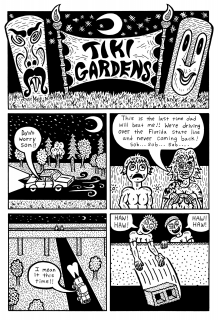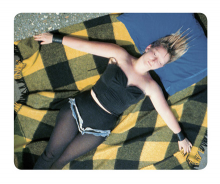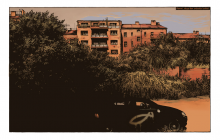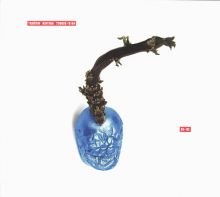| Zeitschrift Umělec 2002/3 >> Hidden scene in Budapest | Übersicht aller Ausgaben | ||||||||||||
|
|||||||||||||
Hidden scene in BudapestZeitschrift Umělec 2002/301.03.2002 Maja a Reuben Fowkes | exhibition | en cs |
|||||||||||||
|
"The manifesto of kmkk (Two Artists, Two Curators), written in autumn last year proclaimed some of the troubles of the present Hungarian art scene. It denounced the lack of an effective infrastructure, the political and commercial manipulation of mainstream culture and problems with the reception and support of contemporary art. In addition, the ignorance of the institutional art apparatus, misunderstandings between artists and curators and the lack of a market for non-conventional culture were pointed out. In their programme, kmkk call for a “healthy and equal exchange of ideas between curators and artists” and announce a return to avantgarde strategies, consciously choosing the periphery of public attention in the hope of awakening the interest of a targeted art public. Through the following winter and spring, the kmkk organised weekly studio events where the works of invited local and visiting artists were presented in an informal setting, sometimes opening their space to guest curators as well. The last sentence of their manifesto reads: “We wait with curiosity to see how the method will work in the shadow of the present institutional structures.”
This summer the Ludwig Museum of Contemporary Art in Budapest presented a major exhibition entitled Budapest Box: Hidden Scene in the 1990s. The exhibition is based on the concept of “the artist as curator” and brings together an eclectic mix of artist-initiated projects from the last 12 years. The curators of the show are Dora Hegyi, organiser of the Project Room for young contemporary art at the Ludwig, and Katalin Timár, an active curator of the “hidden scene.” The visitor is confronted with original art works, historical documentation and occasionally freer presentation of artistic activities. According to the curators, the form of representation was negotiated with the artists concerned, and consequently they chose not to impose a “chronological or logical order” on the overall exhibition layout. However, all accounts of Hungarian art in the 1990s assign a mythical status to the early activities of the Újlak Group, and this exhibition is no exception in the sense of demystification of their position. Újlak was an artist group that first exhibited in the abandoned Hungária Turkish baths in summer 1989, before moving to the deserted Újlak (New Dwelling) Cinema, until it was demolished the following year. From 1991 to 1995 they took over an empty pasta factory in Tőzöltó Street, where they organised one-night shows of invited artists from both Hungary and abroad. These shows were very much “happenings” and often involved the creation of art environments and sound installations. By the mid-1990s the group had split up, as the members chose to follow their own individual paths. In the darkened Újlak room, a seemingly random sequence of slides and video projections remain enigmatic. For a moment we can see a slide of an artist giving a massage to the famous art historian László Beke, but for most viewers the actors stay anonymous and there are no clues as to the identity of the Újlak artists or their work. Another artist-run space from the early 1990s was the Törökfürdő. An abandoned early twentieth century bathhouse, built in the style of Budapest’s many sixteenth and seventeenth century Turkish baths, was used as an occasional site for one-off exhibitions of Hungarian and foreign artists. Most of the works shown were especially created to respond to the atmosphere of the baths. Here we can see photographic documentation of nine projects that took place between 1992 and 1995. It is worth mentioning that Budapest’s famous baths have also been the site for well-known works by Andres Serrano, Katarzyna Kozyra, and Tacita Dean in the later 1990s. The success of Műterem (Studio), opened in July 1993, has been put down to the fact that it offered an alternative to the traditional form of exhibitions in museums and commercial galleries. The size of this experimental gallery was 3 x 5 x 4 metres and it was accessible from the courtyard of a residential building 24 hours a day. It was run by the painter Tamás Kopasz who kept a valuable video record of most of the openings, including an interview with the artist. The more than 50 artists who are listed as having exhibited in Műterem are a roll call of some of the best-known figures of Hungarian contemporary art, including Imre Bukta, Attila Szücs, Tamás Komoróczky, Eike and others. One of the questions raised by this exhibition is why artists chose to set up their own spaces. The curators of Budapest Box see the explanation in the “deficiencies of the official institutional framework,” whose lack of openness and flawed structure prevented artists from realizing their ideas within the existing institutions. This was the case to some extent, however there were a number of “official institutions” in Budapest that took an active role in promoting young artists and new artistic practices throughout the 1990s. A good example, after a successful transformation from the communist system, was the Studio of Young Artists, with the highly popular annual week-long event Gallery by Night as the peak of their activity. Artist-run spaces were also trendy in many other art centres. We could mention Berlin after the fall of the Wall or London in the early 1990s. Here the concept of the “hidden scene” comes also into question. Did the Young British Artists belong to a hidden scene? Or did they, through their practices, choose to short-circuit the traditional hierarchies and institutions of the art establishment? Artist-run projects can be considered a pragmatic strategy for quick artistic success typical for young art scenes in the 1990s. This is indirectly confirmed by the fact that many of the leading figures of the “hidden scene” of the 1990s now head highly established Hungarian art institutions. According to some, what we’re dealing with here is not a “hidden scene” but THE scene. Anyhow, artist-run spaces continue to flourish in the new decade. The kmkk studio events have already been mentioned and are well documented and presented in this exhibition. However, in the opinion of many, the most significant on-going artist-run project of this type is the Kis Varsó (Little Warsaw). Their activity is based on the presentation of an art work by an invited artist followed by an open discussion. The events are announced over the Internet and authoritatively curated by the artists András Gálik and Bálint Havas. Their absence from Budapest Box is very visible, as their activities match the curatorial concept very closely. We have to wonder whether the gap between the demands of the institution and Kis Varsó’s uncompromising independence proved unbridgeable, if it was down to an artist-curator conflict, or did they simply chose to remain kings of the hidden scene? Another kind of activity put into focus by the exhibition is services provided to the Hungarian art world by artists, that elsewhere tend to be in the domain of cultural information centres. Index was initiated by Attila Menesi and Christoph Rauch on the occasion of the exhibition Places of Art at the Balassi Bookshop in April 1999, and is a free bimonthly art listings pamphlet that can be picked up in galleries and museums. For the duration of Budapest Box, representatives of Budapest’s galleries were obliged to come to the Ludwig to pick up their copies of Index, rather than having them delivered by the artists; a move perhaps designed to remind them of the importance of the service they provide. Ikon is an online art listings service run by Endre Koronci since 2000. According to the artist, the main goal is to help galleries organise art events so the openings don’t clash. An interesting feature of their site is that they have a searchable online database of artists and institutions (www.ikon.hu). Within the framework of “artist-run projects,” the exhibition also includes a number of media interventions. Manamana takes the form of a large wall newspaper within the gallery, to which various alternative and anarchist groups contribute by providing news articles that are pasted onto the editorial board in the course of the exhibition. An image of a roast chicken with the inscription “Killed in Croatia” for example, found its way onto the board. As the creation of Tibor Várnagy and Miklós Erhardt, the project aims to stimulate public discourse on issues of global, local, political, social, ecological and cultural concern, and at the same time expose the emptiness and mendacity of the mainstream media. In addition to its presence as a wall newspaper, Manamana is also to be published in three issues as a magazine during the course of the exhibition. JAVA (“Best Of”) is the youngest presented artists’ project, by János Fodor and Tibor Horváth, both still art students. It was realized during the spring of 2002 as a series of video documentaries about the personal art collections of well-known Hungarian artists, or in their words, of “art collections that came into being not on a financial basis but as an investment of spiritual capital.” In a weird way reminiscent of the MTV series about popstars’ houses, Cribs, these young artists went intrepidly with a video camera into the homes of famous Hungarian artists such as Imre Bak and László Fehér exposing not just their art collections, but also their privacy to the gaze of the curious art world. The authors’ attempt to keep themselves out of the picture (and sound) goes to the heart of the ambiguity between documentation and artistic creation. The case of Balázs Beöthy, represented in at least four artist-run projects featured in the exhibition and the only artist commissioned to create a new work for the show, raises the question of whether he is the most hidden or best established Hungarian artist… Green consists of objects “borrowed from artists and art historians active in the Budapest scene that can be connected with the concept of green.” In the statement accompanying the work, the artist offers the disclaimer that since he accepted all the objects offered without exception and made no other conditions and although it contains some art works, it “cannot be described as a curatorial selection.” The objects hang from the ceiling at eye level and an inventory on the wall lists the names of the collaborators and a description of the object they provided allowing the viewer to examine their concept of green: for instance, Júlia Fabényi, director of the Kunsthalle, gave a pair of green slippers. Finally, a number of works directly address the current problems of the Budapest art scene. Milieu et L’EGO involves using a giant table and Lego pieces to address three burning questions to the curators: “Why do you think there are no Hungarian artists at Documenta 11? According to your experiences, what are the criteria for artists to get a fee for participating in exhibitions? What is the target audience for this exhibition?” On the basis of the curators answers, the artists behind L’EGO will respond. Accompanying the documentation of the kmkk studio events, a new installation was presented to stress the relevance of the project. It consists of a carpet upon which an original Budapest voting box has been placed. The museum visitors are asked to nominate the “problems of Hungarian art that have been swept under the carpet.” Hidden behind this intervention on the borders of documentation and art work is the unmistakable presence of the leading figure of kmkk, the well-known artist and art pedagogue, János Sugár. Towards the end of the exhibition the box will be opened at a satellite event and the issues discussed in public. We can’t help wondering whether this installation placed at the centre of the exhibition is the epitome of the Budapest Box. Budapest Box: The Hidden Scene in the 1990s, 4 July – 29 September 2002. Ludwig Museum of Contemporary Art, Budapest "
01.03.2002
Empfohlene Artikel
|
|||||||||||||
|
04.02.2020 10:17
Letošní 50. ročník Art Basel přilákal celkem 93 000 návštěvníků a sběratelů z 80 zemí světa. 290 prémiových galerií představilo umělecká díla od počátku 20. století až po současnost. Hlavní sektor přehlídky, tradičně v prvním patře výstavního prostoru, představil 232 předních galerií z celého světa nabízející umění nejvyšší kvality. Veletrh ukázal vzestupný trend prodeje prostřednictvím galerií jak soukromým sbírkám, tak i institucím. Kromě hlavního veletrhu stály za návštěvu i ty přidružené: Volta, Liste a Photo Basel, k tomu doprovodné programy a výstavy v místních institucích, které kvalitou daleko přesahují hranice města tj. Kunsthalle Basel, Kunstmuseum, Tinguely muzeum nebo Fondation Beyeler.
|


































 We Are Rising National Gallery For You! Go to Kyjov by Krásná Lípa no.37.
We Are Rising National Gallery For You! Go to Kyjov by Krásná Lípa no.37.
Kommentar
Der Artikel ist bisher nicht kommentiert wordenNeuen Kommentar einfügen